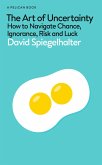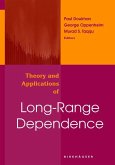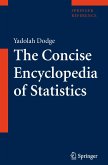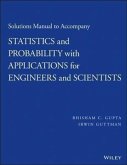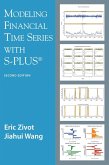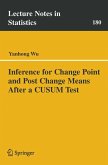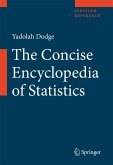Schade – dieser Artikel ist leider ausverkauft. Sobald wir wissen, ob und wann der Artikel wieder verfügbar ist, informieren wir Sie an dieser Stelle.
- Gebundenes Buch
- Merkliste
- Auf die Merkliste
- Bewerten Bewerten
- Teilen
- Produkt teilen
- Produkterinnerung
- Produkterinnerung
Rev. ed of: Statistics through applications / Daren S. Starnes, Daniel S. Yates, David S. Moore. 2nd ed.
Andere Kunden interessierten sich auch für
![The Art of Uncertainty The Art of Uncertainty]() David SpiegelhalterThe Art of Uncertainty21,83 €
David SpiegelhalterThe Art of Uncertainty21,83 €![Theory and Applications of Long-Range Dependence Theory and Applications of Long-Range Dependence]() P. Doukhan / M.S. Taqqu / G. Oppenheim (eds.)Theory and Applications of Long-Range Dependence107,99 €
P. Doukhan / M.S. Taqqu / G. Oppenheim (eds.)Theory and Applications of Long-Range Dependence107,99 €![The Concise Encyclopedia of Statistics The Concise Encyclopedia of Statistics]() Yadolah DodgeThe Concise Encyclopedia of Statistics49,99 €
Yadolah DodgeThe Concise Encyclopedia of Statistics49,99 €![Solutions Manual to Accompany Statistics and Probability with Applications for Engineers and Scientists Solutions Manual to Accompany Statistics and Probability with Applications for Engineers and Scientists]() Bhisham C GuptaSolutions Manual to Accompany Statistics and Probability with Applications for Engineers and Scientists37,99 €
Bhisham C GuptaSolutions Manual to Accompany Statistics and Probability with Applications for Engineers and Scientists37,99 €![Modeling Financial Time Series with S-Plus(r) Modeling Financial Time Series with S-Plus(r)]() Eric ZivotModeling Financial Time Series with S-Plus(r)107,99 €
Eric ZivotModeling Financial Time Series with S-Plus(r)107,99 €![Inference for Change Point and Post Change Means After a Cusum Test Inference for Change Point and Post Change Means After a Cusum Test]() Wu YanhongInference for Change Point and Post Change Means After a Cusum Test53,99 €
Wu YanhongInference for Change Point and Post Change Means After a Cusum Test53,99 €![The Concise Encyclopedia of Statistics The Concise Encyclopedia of Statistics]() Yadolah DodgeThe Concise Encyclopedia of Statistics185,99 €
Yadolah DodgeThe Concise Encyclopedia of Statistics185,99 €-
-
-
Rev. ed of: Statistics through applications / Daren S. Starnes, Daniel S. Yates, David S. Moore. 2nd ed.
Produktdetails
- Produktdetails
- Verlag: Macmillan Learning / W. H. Freeman
- 3rd edition
- Seitenzahl: 800
- Erscheinungstermin: 30. September 2016
- Englisch
- Abmessung: 274mm x 216mm x 33mm
- Gewicht: 1733g
- ISBN-13: 9781464122163
- ISBN-10: 1464122164
- Artikelnr.: 49380605
- Herstellerkennzeichnung
- Libri GmbH
- Europaallee 1
- 36244 Bad Hersfeld
- gpsr@libri.de
- Verlag: Macmillan Learning / W. H. Freeman
- 3rd edition
- Seitenzahl: 800
- Erscheinungstermin: 30. September 2016
- Englisch
- Abmessung: 274mm x 216mm x 33mm
- Gewicht: 1733g
- ISBN-13: 9781464122163
- ISBN-10: 1464122164
- Artikelnr.: 49380605
- Herstellerkennzeichnung
- Libri GmbH
- Europaallee 1
- 36244 Bad Hersfeld
- gpsr@libri.de
Daren Starnes; Josh Tabor
About the Authors
Acknowledgments
To the Student
Chapter 1 Analyzing One-Variable Data
Lesson 1.1 Statistics: The Science and Art of Data
Lesson 1.2 Displaying Categorical Data
Lesson 1.3 Displaying Quantitative Data: Dotplots
Lesson 1.4 Displaying Quantitative Data: Stemplots
Lesson 1.5 Displaying Quantitative Data: Histograms
Lesson 1.6 Measuring Center
Lesson 1.7 Measuring Variability
Lesson 1.8 Summarizing Quantitative Data: Boxplots and Outliers
Chapter 2 Modeling One-Variable Quantitative Data
Lesson 2.1 Describing Location in a Distribution
Lesson 2.2 Transforming Data
Lesson 2.3 Density Curves and the Normal Distribution
Lesson 2.4 The Empirical Rule and Assessing Normality
Lesson 2.5 Normal Distributions: Finding Areas from Values
Lesson 2.6 Normal Distributions: Finding Values from Areas
Chapter 3 Analyzing Two-Variable Data
Lesson 3.1 Relationships Between Two Categorical Variables
Lesson 3.2 Relationships Between Two Quantitative Variables
Lesson 3.3 Correlation
Lesson 3.4 More about Correlation
Lesson 3.5 Regression Lines
Lesson 3.6 The Least-Squares Regression Line
Lesson 3.7 Assessing a Regression Model
Chapter 4 Collecting Data
Lesson 4.1 Introduction to Data Collection
Lesson 4.2 Sampling: Good and Bad
Lesson 4.3 Sampling and Surveys
Lesson 4.4 Inference for Sampling
Lesson 4.5 Observational Studies and Experiments
Lesson 4.6 How to Experiment Well
Lesson 4.7 Inference for Experiments
Lesson 4.8 Using Studies Wisely
Chapter 5 Probability
Lesson 5.1 Randomness, Probability, and Simulation
Lesson 5.2 Basic Probability Rules
Lesson 5.3 Two-Way Tables and Venn Diagrams
Lesson 5.4 Conditional Probability and Independence
Lesson 5.5 The General Multiplication Rule and Tree Diagrams
Lesson 5.6 The Multiplication Rule for Independent Events
Lesson 5.7 The Multiplication Counting Principle and Permutations
Lesson 5.8 Combinations and Probability
Chapter 6 Random Variables
Lesson 6.1 Two Types of Random Variables
Lesson 6.2 Analyzing Discrete Random Variables
Lesson 6.3 Binomial Random Variables
Lesson 6.4 Analyzing Binomial Random Variables
Lesson 6.5 Normal Approximation to Binomial Distributions
Chapter 7 Sampling Distributions
Lesson 7.1 What Is a Sampling Distribution?
Lesson 7.2 Sampling Distributions: Center and Variability
Lesson 7.3 The Sampling Distribution of a Sample Proportion
Lesson 7.4 The Sampling Distribution of a Sample Mean
Lesson 7.5 The Central Limit Theorem
Chapter 8 Estimating a Parameter
Lesson 8.1 The Idea of a Confidence Interval
Lesson 8.2 What Affects the Margin of Error?
Lesson 8.3 Estimating a Proportion
Lesson 8.4 Confidence Intervals for a Proportion
Lesson 8.5 Estimating a Mean
Lesson 8.6 Confidence Intervals for a Mean
Chapter 9 Testing a Claim
Lesson 9.1 The Idea of a Significance Test
Lesson 9.2 Significance Tests and Decision Making
Lesson 9.3 Testing a Claim about a Proportion
Lesson 9.4 Significance Tests for a Proportion
Lesson 9.5 Testing a Claim about a Mean
Lesson 9.6 Significance Tests for a Mean
Chapter 10 Comparing Two Populations or Treatments
Lesson 10.1 Estimating a Difference Between Two Proportions
Lesson 10.2 Testing a Claim about a Difference Between Two Proportions
Lesson 10.3 Estimating a Difference Between Two Means
Lesson 10.4 Testing a Claim about a Difference Between Two Means
Lesson 10.5 Paired Data: Estimating a Mean Difference
Lesson 10.6 Paired Data: Testing a Claim about a Mean Difference
Chapter 11 Inference for Distributions and Relationships
Lesson 11.1 Testing the Distribution of a Categorical Variable
Lesson 11.2 Chi-Square Tests for Goodness of Fit
Lesson 11.3 Testing the Relationship Between Two Categorical Variables
Lesson 11.4 Chi-Square Tests for Association
Lesson 11.5 Estimating the Slope of a Least-Squares Regression Line
Lesson 11.6 Testing a Claim about the Slope of a Least-Squares Regression
Line
Acknowledgments
To the Student
Chapter 1 Analyzing One-Variable Data
Lesson 1.1 Statistics: The Science and Art of Data
Lesson 1.2 Displaying Categorical Data
Lesson 1.3 Displaying Quantitative Data: Dotplots
Lesson 1.4 Displaying Quantitative Data: Stemplots
Lesson 1.5 Displaying Quantitative Data: Histograms
Lesson 1.6 Measuring Center
Lesson 1.7 Measuring Variability
Lesson 1.8 Summarizing Quantitative Data: Boxplots and Outliers
Chapter 2 Modeling One-Variable Quantitative Data
Lesson 2.1 Describing Location in a Distribution
Lesson 2.2 Transforming Data
Lesson 2.3 Density Curves and the Normal Distribution
Lesson 2.4 The Empirical Rule and Assessing Normality
Lesson 2.5 Normal Distributions: Finding Areas from Values
Lesson 2.6 Normal Distributions: Finding Values from Areas
Chapter 3 Analyzing Two-Variable Data
Lesson 3.1 Relationships Between Two Categorical Variables
Lesson 3.2 Relationships Between Two Quantitative Variables
Lesson 3.3 Correlation
Lesson 3.4 More about Correlation
Lesson 3.5 Regression Lines
Lesson 3.6 The Least-Squares Regression Line
Lesson 3.7 Assessing a Regression Model
Chapter 4 Collecting Data
Lesson 4.1 Introduction to Data Collection
Lesson 4.2 Sampling: Good and Bad
Lesson 4.3 Sampling and Surveys
Lesson 4.4 Inference for Sampling
Lesson 4.5 Observational Studies and Experiments
Lesson 4.6 How to Experiment Well
Lesson 4.7 Inference for Experiments
Lesson 4.8 Using Studies Wisely
Chapter 5 Probability
Lesson 5.1 Randomness, Probability, and Simulation
Lesson 5.2 Basic Probability Rules
Lesson 5.3 Two-Way Tables and Venn Diagrams
Lesson 5.4 Conditional Probability and Independence
Lesson 5.5 The General Multiplication Rule and Tree Diagrams
Lesson 5.6 The Multiplication Rule for Independent Events
Lesson 5.7 The Multiplication Counting Principle and Permutations
Lesson 5.8 Combinations and Probability
Chapter 6 Random Variables
Lesson 6.1 Two Types of Random Variables
Lesson 6.2 Analyzing Discrete Random Variables
Lesson 6.3 Binomial Random Variables
Lesson 6.4 Analyzing Binomial Random Variables
Lesson 6.5 Normal Approximation to Binomial Distributions
Chapter 7 Sampling Distributions
Lesson 7.1 What Is a Sampling Distribution?
Lesson 7.2 Sampling Distributions: Center and Variability
Lesson 7.3 The Sampling Distribution of a Sample Proportion
Lesson 7.4 The Sampling Distribution of a Sample Mean
Lesson 7.5 The Central Limit Theorem
Chapter 8 Estimating a Parameter
Lesson 8.1 The Idea of a Confidence Interval
Lesson 8.2 What Affects the Margin of Error?
Lesson 8.3 Estimating a Proportion
Lesson 8.4 Confidence Intervals for a Proportion
Lesson 8.5 Estimating a Mean
Lesson 8.6 Confidence Intervals for a Mean
Chapter 9 Testing a Claim
Lesson 9.1 The Idea of a Significance Test
Lesson 9.2 Significance Tests and Decision Making
Lesson 9.3 Testing a Claim about a Proportion
Lesson 9.4 Significance Tests for a Proportion
Lesson 9.5 Testing a Claim about a Mean
Lesson 9.6 Significance Tests for a Mean
Chapter 10 Comparing Two Populations or Treatments
Lesson 10.1 Estimating a Difference Between Two Proportions
Lesson 10.2 Testing a Claim about a Difference Between Two Proportions
Lesson 10.3 Estimating a Difference Between Two Means
Lesson 10.4 Testing a Claim about a Difference Between Two Means
Lesson 10.5 Paired Data: Estimating a Mean Difference
Lesson 10.6 Paired Data: Testing a Claim about a Mean Difference
Chapter 11 Inference for Distributions and Relationships
Lesson 11.1 Testing the Distribution of a Categorical Variable
Lesson 11.2 Chi-Square Tests for Goodness of Fit
Lesson 11.3 Testing the Relationship Between Two Categorical Variables
Lesson 11.4 Chi-Square Tests for Association
Lesson 11.5 Estimating the Slope of a Least-Squares Regression Line
Lesson 11.6 Testing a Claim about the Slope of a Least-Squares Regression
Line
About the Authors
Acknowledgments
To the Student
Chapter 1 Analyzing One-Variable Data
Lesson 1.1 Statistics: The Science and Art of Data
Lesson 1.2 Displaying Categorical Data
Lesson 1.3 Displaying Quantitative Data: Dotplots
Lesson 1.4 Displaying Quantitative Data: Stemplots
Lesson 1.5 Displaying Quantitative Data: Histograms
Lesson 1.6 Measuring Center
Lesson 1.7 Measuring Variability
Lesson 1.8 Summarizing Quantitative Data: Boxplots and Outliers
Chapter 2 Modeling One-Variable Quantitative Data
Lesson 2.1 Describing Location in a Distribution
Lesson 2.2 Transforming Data
Lesson 2.3 Density Curves and the Normal Distribution
Lesson 2.4 The Empirical Rule and Assessing Normality
Lesson 2.5 Normal Distributions: Finding Areas from Values
Lesson 2.6 Normal Distributions: Finding Values from Areas
Chapter 3 Analyzing Two-Variable Data
Lesson 3.1 Relationships Between Two Categorical Variables
Lesson 3.2 Relationships Between Two Quantitative Variables
Lesson 3.3 Correlation
Lesson 3.4 More about Correlation
Lesson 3.5 Regression Lines
Lesson 3.6 The Least-Squares Regression Line
Lesson 3.7 Assessing a Regression Model
Chapter 4 Collecting Data
Lesson 4.1 Introduction to Data Collection
Lesson 4.2 Sampling: Good and Bad
Lesson 4.3 Sampling and Surveys
Lesson 4.4 Inference for Sampling
Lesson 4.5 Observational Studies and Experiments
Lesson 4.6 How to Experiment Well
Lesson 4.7 Inference for Experiments
Lesson 4.8 Using Studies Wisely
Chapter 5 Probability
Lesson 5.1 Randomness, Probability, and Simulation
Lesson 5.2 Basic Probability Rules
Lesson 5.3 Two-Way Tables and Venn Diagrams
Lesson 5.4 Conditional Probability and Independence
Lesson 5.5 The General Multiplication Rule and Tree Diagrams
Lesson 5.6 The Multiplication Rule for Independent Events
Lesson 5.7 The Multiplication Counting Principle and Permutations
Lesson 5.8 Combinations and Probability
Chapter 6 Random Variables
Lesson 6.1 Two Types of Random Variables
Lesson 6.2 Analyzing Discrete Random Variables
Lesson 6.3 Binomial Random Variables
Lesson 6.4 Analyzing Binomial Random Variables
Lesson 6.5 Normal Approximation to Binomial Distributions
Chapter 7 Sampling Distributions
Lesson 7.1 What Is a Sampling Distribution?
Lesson 7.2 Sampling Distributions: Center and Variability
Lesson 7.3 The Sampling Distribution of a Sample Proportion
Lesson 7.4 The Sampling Distribution of a Sample Mean
Lesson 7.5 The Central Limit Theorem
Chapter 8 Estimating a Parameter
Lesson 8.1 The Idea of a Confidence Interval
Lesson 8.2 What Affects the Margin of Error?
Lesson 8.3 Estimating a Proportion
Lesson 8.4 Confidence Intervals for a Proportion
Lesson 8.5 Estimating a Mean
Lesson 8.6 Confidence Intervals for a Mean
Chapter 9 Testing a Claim
Lesson 9.1 The Idea of a Significance Test
Lesson 9.2 Significance Tests and Decision Making
Lesson 9.3 Testing a Claim about a Proportion
Lesson 9.4 Significance Tests for a Proportion
Lesson 9.5 Testing a Claim about a Mean
Lesson 9.6 Significance Tests for a Mean
Chapter 10 Comparing Two Populations or Treatments
Lesson 10.1 Estimating a Difference Between Two Proportions
Lesson 10.2 Testing a Claim about a Difference Between Two Proportions
Lesson 10.3 Estimating a Difference Between Two Means
Lesson 10.4 Testing a Claim about a Difference Between Two Means
Lesson 10.5 Paired Data: Estimating a Mean Difference
Lesson 10.6 Paired Data: Testing a Claim about a Mean Difference
Chapter 11 Inference for Distributions and Relationships
Lesson 11.1 Testing the Distribution of a Categorical Variable
Lesson 11.2 Chi-Square Tests for Goodness of Fit
Lesson 11.3 Testing the Relationship Between Two Categorical Variables
Lesson 11.4 Chi-Square Tests for Association
Lesson 11.5 Estimating the Slope of a Least-Squares Regression Line
Lesson 11.6 Testing a Claim about the Slope of a Least-Squares Regression
Line
Acknowledgments
To the Student
Chapter 1 Analyzing One-Variable Data
Lesson 1.1 Statistics: The Science and Art of Data
Lesson 1.2 Displaying Categorical Data
Lesson 1.3 Displaying Quantitative Data: Dotplots
Lesson 1.4 Displaying Quantitative Data: Stemplots
Lesson 1.5 Displaying Quantitative Data: Histograms
Lesson 1.6 Measuring Center
Lesson 1.7 Measuring Variability
Lesson 1.8 Summarizing Quantitative Data: Boxplots and Outliers
Chapter 2 Modeling One-Variable Quantitative Data
Lesson 2.1 Describing Location in a Distribution
Lesson 2.2 Transforming Data
Lesson 2.3 Density Curves and the Normal Distribution
Lesson 2.4 The Empirical Rule and Assessing Normality
Lesson 2.5 Normal Distributions: Finding Areas from Values
Lesson 2.6 Normal Distributions: Finding Values from Areas
Chapter 3 Analyzing Two-Variable Data
Lesson 3.1 Relationships Between Two Categorical Variables
Lesson 3.2 Relationships Between Two Quantitative Variables
Lesson 3.3 Correlation
Lesson 3.4 More about Correlation
Lesson 3.5 Regression Lines
Lesson 3.6 The Least-Squares Regression Line
Lesson 3.7 Assessing a Regression Model
Chapter 4 Collecting Data
Lesson 4.1 Introduction to Data Collection
Lesson 4.2 Sampling: Good and Bad
Lesson 4.3 Sampling and Surveys
Lesson 4.4 Inference for Sampling
Lesson 4.5 Observational Studies and Experiments
Lesson 4.6 How to Experiment Well
Lesson 4.7 Inference for Experiments
Lesson 4.8 Using Studies Wisely
Chapter 5 Probability
Lesson 5.1 Randomness, Probability, and Simulation
Lesson 5.2 Basic Probability Rules
Lesson 5.3 Two-Way Tables and Venn Diagrams
Lesson 5.4 Conditional Probability and Independence
Lesson 5.5 The General Multiplication Rule and Tree Diagrams
Lesson 5.6 The Multiplication Rule for Independent Events
Lesson 5.7 The Multiplication Counting Principle and Permutations
Lesson 5.8 Combinations and Probability
Chapter 6 Random Variables
Lesson 6.1 Two Types of Random Variables
Lesson 6.2 Analyzing Discrete Random Variables
Lesson 6.3 Binomial Random Variables
Lesson 6.4 Analyzing Binomial Random Variables
Lesson 6.5 Normal Approximation to Binomial Distributions
Chapter 7 Sampling Distributions
Lesson 7.1 What Is a Sampling Distribution?
Lesson 7.2 Sampling Distributions: Center and Variability
Lesson 7.3 The Sampling Distribution of a Sample Proportion
Lesson 7.4 The Sampling Distribution of a Sample Mean
Lesson 7.5 The Central Limit Theorem
Chapter 8 Estimating a Parameter
Lesson 8.1 The Idea of a Confidence Interval
Lesson 8.2 What Affects the Margin of Error?
Lesson 8.3 Estimating a Proportion
Lesson 8.4 Confidence Intervals for a Proportion
Lesson 8.5 Estimating a Mean
Lesson 8.6 Confidence Intervals for a Mean
Chapter 9 Testing a Claim
Lesson 9.1 The Idea of a Significance Test
Lesson 9.2 Significance Tests and Decision Making
Lesson 9.3 Testing a Claim about a Proportion
Lesson 9.4 Significance Tests for a Proportion
Lesson 9.5 Testing a Claim about a Mean
Lesson 9.6 Significance Tests for a Mean
Chapter 10 Comparing Two Populations or Treatments
Lesson 10.1 Estimating a Difference Between Two Proportions
Lesson 10.2 Testing a Claim about a Difference Between Two Proportions
Lesson 10.3 Estimating a Difference Between Two Means
Lesson 10.4 Testing a Claim about a Difference Between Two Means
Lesson 10.5 Paired Data: Estimating a Mean Difference
Lesson 10.6 Paired Data: Testing a Claim about a Mean Difference
Chapter 11 Inference for Distributions and Relationships
Lesson 11.1 Testing the Distribution of a Categorical Variable
Lesson 11.2 Chi-Square Tests for Goodness of Fit
Lesson 11.3 Testing the Relationship Between Two Categorical Variables
Lesson 11.4 Chi-Square Tests for Association
Lesson 11.5 Estimating the Slope of a Least-Squares Regression Line
Lesson 11.6 Testing a Claim about the Slope of a Least-Squares Regression
Line


